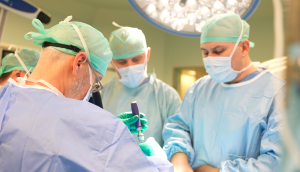
COMPREHENSIVE NEUROSURGICAL (BRAIN & SPINE) CENTER
COMPREHENSIVE NEUROSURGICAL (BRAIN & SPINE) CENTER
One of the largest and most comprehensive neurosurgical practices in Europe!

Anadolu Medical Center provides cutting-edge neurosurgical services, encompassing intricate and life-saving procedures designed to aid both adults and children facing complex health issues. Our globally recognized neurosurgeons are at the forefront of addressing conditions related to the brain, spine, and nervous system, employing advanced techniques like minimally invasive neurosurgery, robotics, intraoperative MRI, stereotactic radiosurgery, and deep brain stimulation.
Our center provides multidisciplinary clinical care in collborations with various disciplines under the umbrella of Neuro-oncology and Neuro-vascular Boards;
- Neuro-oncology
- Benign and Malignant Brain Tumors
- Neuroradiology
- Stenting & Embolism
- AVM (arteriovenous malformation)
- Aneurysms
- Carotid Stenosis
- Advanced Neuro-radiological Modalities
- Tractographies
- Spectrometer
- DTI (Diffusion tensor imaging)
- Neurology
- DBS (Deep Brain Stimulation)
- Pain Modulation
- Trapping
- VNS (Vagus Nerve Stimulation)
- Radiosurgery (Cyberknife)
- Neurovascular Surgery
- Aneurysms
- AVM (arteriovenous malformation)
- Cavernoma
- Comprehensive Spine Center
- Degenerative Spine Diseases
- Lumbar and Cervical Disc Herniation (Microsurgery)
- Degenerative Spine Deformities
- Vertebra & Spinal Cord Tumors
- Trauma
- Metabolic Disorders
- Osteoporotic Spine
- Peripheral Nerve Surgery
- Brachial Plexus Surgery
- Degenerative Spine Diseases
- Stenting & Embolism
“Stereotactic Brain Biopsy”
In situations in which surgical resection is not necessarily indicated but diagnosis of a brain lesion is needed to determine optimal treatment, a stereotactic brain biopsy offers a relatively safe and reliable method of obtaining diagnostic tissue. Our neurosurgery team is vastly experienced in this advanced diagnostic technique. The risks associated with stereotactic brain biopsy are minimal.”
Everything is for the “safest” surgeries:
Hybrid Operating Room
Hybrid operating room is a term used for the new types of operating rooms in which advanced medical imaging systems and medical devices can be used together simultaneously.
In fact, it started in 1970s with the use of mobile x-ray devices (C-arm fluoroscopy) in the operating rooms, but today it has reached to a whole new level. Today, following the introduction of mobile computed tomography (CT) and magnetic resonance (MR), today with the introduction of neuro-navigation which determines the operation target and neuro-monitorization device (monitoring the operation processes in the brain and nerve function), we can say that it has fully reached the hybrid concept. With the addition of the operating microscopes with special fluorescent filter integrated and navigation systems, the separation of tumors from normal nerve tissues is now easier. In other words, microscopes are now also included in the concept of “hybrid”.
NEURO-NAVIGATION SYSTEM
Navigation that recognizes all the pathways of the brain
It calculates the coordinates of the surgical site and reaches the target with minimal deviation. Thus, the risk of death or injury is minimized. The new generation of neuronavigation, the which is “direction finding or orientation” system, calculates the coordinates with a system similar to GPS technology for a target within the brain or spinal cord surgery and enables the surgeon to see the 3-dimensional scanned images. Neuronavigation, which is a high-end computer technology, approaches the targeted lesion in neurosurgery with a high degree of accuracy (less than 1 mm). This, of course, can minimize the damage to healthy tissue during surgery. In this method, the patient’s MRI and/or CT is taken and transferred to the navigation device before surgery. Thus, during surgery, real-time navigation of the patient’s brain and spine can be visualized and planning is made accordingly.
This method can be used together with other technologies or it can be used by itself only. Stereotaxic biopsy can be performed in all cases with small and deeply located tumors and with the help of a small entrance hole. In other words, a thin needle reaches directly to the region in millimeters and tissue samples are taken. And, of course, the pathological examination of this tissue sample determines which treatment method will be used for the treatment of patient.
INTRAOPERATIVE NEUROMONITORIZATION
Critical points of the brain are broadcast live on the screen!
It is a system that provides continuous monitoring of the brain, spinal cord, nerve roots and reflex pathways by electrodes placed on the muscles of the patient’s scalp during the surgery in order to minimize the damage (risk of stroke) of the nerves that may develop due to brain tumor and spine surgeries. The system warns the surgeon when there is a change in the values followed by the neurologist throughout the surgery. Thus, the patient is prevented from developing irreversible damage (such as paralysis), thus also preventing the reducing the quality of life. The patient can return home and work in a short time.
Mehmet Caglar Berk, MD is a neurosurgeon with double fellowship training; both in Stereotactic, Functional & Restorative Neurosurgery and Pediatric Neurosurgery.
He is Board Certified by: The American Board of Neurological Surgery (ABNS), European Association of Neurosurgical Societies (EANS), and the Turkish Board of Neurosurgery.
He also holds the Licentiate of Medical Council of Canada (LMCC).
Dr. Berk earned his medical degree from Hacettepe University, in his native country – Turkey. He reached the rank of Associate Professor of Neurosurgery before embarking on his career in the USA.
Dr. Berk also completed residency training in Neurological Surgery, and a postgraduate certificate program in Human Investigations at Oregon Health & Science University in Portland. Dr. Berk’s research focuses on clinical outcomes and he authored numerous publications in peer-reviewed journals. Dr. Berk has clinical expertise in complex neurosurgical problems, with special focus on functional neurosurgery and image guided minimally invasive spine surgery.
He is board-certified and fellowship trained in the implantation of nerve, spinal cord and deep brain stimulators. He has performed more thatn 2.000 deep brain stimulation surgeries until now.

